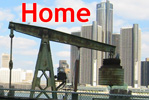

  |
|
last modified: Sunday, December 18, 2005 8:44 PM |
|
The
Economic Benefits of Building Green |
|
Lindsay-Jean
Hard |
lgilreat@umich.edu |
Why should we build green? Our world consists of a limited number of resources, and so necessarily, we need to live in a manner that preserves these resources for future generations. According to the U.S. Green Building Council, “…buildings in the United States account for 65 percent of electricity consumption, 36 percent of total energy usage, 30 percent of greenhouse gas emissions, 12 percent of potable water consumption, and 30 percent of raw materials usage.” [1] These are disheartening numbers, but green building techniques can help reduce or even eliminate the impact of buildings on the environment, create a healthy and enjoyable place to live or work, and still be profitable ventures.
First of all, it is essential to understand what green building means and what it entails. One component of green building is often LEED (Leadership in Energy and Environmental Design) certification. LEED certification is not mandatory for green built projects, but it is helping to define green building practices, and set the standard for green and sustainable buildings. Another key factor of green building is sustainability, or sustainable development, which deals with developing responsibly, in order to preserve natural resources for future generations. One helpful definition of green building describes the ideal green project as one which “…preserves and restores habitat that is vital for sustaining life and becomes a net producer and exporter of resources, materials, energy and water rather that being a net consumer. A green building is one whose construction and lifetime of operation assure the healthiest possible environment while representing the most efficient and least disruptive use of land, water, energy and resources. The optimum design solution is one that effectively emulates all of the natural systems and conditions of the pre-developed site—after development is complete.” [2]
So there are obviously environmental benefits for building green, but beyond that, what can green built projects do for us? Well, there are major economic benefits to building green…
Number
1: It Does Not Have To Cost More To Build Green, In Fact, It Can Cost Less!
Green
building has gotten a bad rap as being much more cost-prohibitive than traditional
non-green building technologies. Although it is true that many green resources and technologies
cost more than traditional building supplies, some green materials have a
comparable cost, or even a slightly lower price tag than non-green materials. So
by choosing which green materials to use on a project, and which to forgo,
the initial cost of a green building can be very similar to the initial cost
of a non-green building. Furthermore,
and perhaps more importantly, green-built projects really provide a cost-savings
over the project’s lifetime, which offsets any higher initial cost. Namely, green buildings use less energy than non-green buildings,
which results in lower operating costs as well as lower energy bills over
the lifetime of the building.
[3]
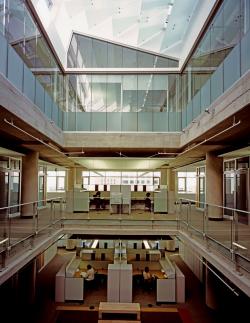
Photo and caption courtesy
of http://www.buildinggreen.com/auth/article.cfm?fileName=140401a.xml
Green built projects are very energy efficient, and can save energy in a variety of ways. For example, green buildings often take full advantage of natural daylight—through positioning of windows, use of skylights, and thinking about the building’s solar orientation—which reduces the use of artificial lighting and consequently, electricity consumption. Natural ventilation, solar energy, water conservation techniques, and more efficient appliances can also be used to reduce water consumption, the use of traditional heating and cooling systems, and energy expenditure. [4] Through these and a variety of other energy saving techniques, most green buildings use about half as much energy as their non-green counterparts, and some use less than a quarter as much energy! [5]
Savings can also be found through a number of first-cost—or non-reoccurring cost—savings opportunities. Green built projects often employ a more efficient and effective use of space, frequently resulting in smaller, more compact buildings. Green buildings also often make changes in infrastructure that can result in significant savings. As an example, “innovative stormwater infiltration systems can reduce or eliminate the need for storm sewers and stormwater detention ponds; narrower streets to slow traffic can reduce paved area; and clustering buildings on a site can reduce the amount of paved area and the length of sewers and utility lines.” [6] This saves money by reducing the amount of material used as well as reducing construction waste—this is also resource efficient. Another opportunity for cost savings lies in the potential for reduced regulatory delays and a streamlined approval process. For example if a green built project is designed to maximize the amount of open space in the plan, there might be less opposition from the municipality’s planning commission and local special interest groups. Additionally, some municipalities are so in favor of green built developments that they offer tax credits, expedited permitting or other financial incentives to promote green building. [7]
Number 2: Green Built Projects Improve Worker Productivity
Green built projects provide a healthier and more comfortable indoor environment, which results in higher levels of worker performance and reduced levels of absenteeism. A healthy indoor environment can reduce allergy symptoms, asthma symptoms, and rates of communicable respiratory illnesses. Not surprisingly, a healthy worker is more productive than one who is feeling a little under the weather or a worker using a sick day. In turn, healthier working conditions reduce a company’s health care expenditures and minimize the costs associated with reduced productivity—whether the ailing worker is just not performing at their full capability, or is at home sick. [8]
Another benefit of green built projects in terms of worker productivity is reduced costs of churn. Churn is known as the costs associated with relocating office workers and reconfiguring office spaces, which is a large expense for many companies. The churn rate for offices can range from 25% to as much as 100%, which can be considerably reduced by green building techniques. [9]
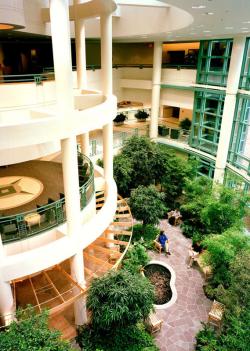
Image 2: “An abundance
of daylight, plants, natural colors, textures, and artwork are intended
to promote healing and comfort for patients and visitors at the Bronson
Methodist Hospital in Kalamazoo, Michigan.”
Photo and caption courtesy
of http://www.buildinggreen.com/auth/article.cfm?fileName=140401a.xml
Additionally,
the characteristics of non-green built buildings and indoor environments
have been associated with sick-building syndrome (SBS) symptoms.
[10]
This is when building occupants experience building-related
health symptoms such as, “irritation of eyes, nose, and skin, headache,
fatigue, and difficulty breathing.”
[11]
And disturbingly, “Americans spend
an average of 90 percent of their time indoors, and many common building
products…emit formaldehyde or other chemicals known…to have
health impacts.”
[12]
With this in mind, it seems obvious that
incorporating healthy details like more daylight, better ventilation, thermal
comfort, and outdoor views result in healthier and more productive workers.
Number
3: Building Green is Resource
Efficient
Green building increases the demand for recycled materials, which in turn increases the demand for construction waste and the raw materials collected in local recycling programs. Using recycled material is often less expensive than disposing of it, which reduces the amount of waste going into landfills, and lessens the consumption of natural resources. [13] Waste generation can also be reduced inside of the building as well. As examples, buildings can provide recycling facilities, and hotels can use dispensers for personal care items (like soap, shampoo, and conditioner) in order to reduce the amount of small bottles thrown away. [14]
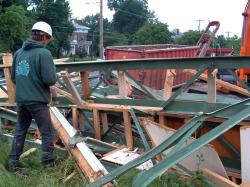
Image 3: “To make room
for a Student Life complex at Champlain College in Burlington, Vermont,
Pizzagalli Construction dismantled an old one-story cafeteria. Much of
the equipment and the structure was salvaged
or recycled, reducing landfill costs.” Photo and caption courtesy
of http://www.buildinggreen.com/auth/article.cfm?fileName=140401a.xml
Green built projects often incorporate responsible land use as well. Reusing brownfield sites, increasing infill development, and encouraging the redevelopment of underutilized sites all reduce the consumption of open space or farmland. This practice also can reduce sprawl in a community, and consequently can ease a municipality’s transportation responsibilities since the use of these types of sites are often located in urbanized areas nearer to jobs and services. [15]
Additionally, the LEED rating system provides points for the use of local materials, so green built projects increase the likelihood of using local materials, thus stimulating the local economy. Using more local materials reduces the impacts of transporting building materials and products for long distances, saving energy, time, and money. [16]
Green built projects are resource efficient in a variety of other ways as well. Green built projects cost less to operate because they are well-built and highly durable, reducing the frequency of repairs and replacement. Furthermore, green buildings can reduce the cost of cleaning and maintenance. For example, landscaping with native plants generally requires much less maintenance than traditional shrubbery, thus saving money.
Number
4: Green Built Projects Offer
New Business Opportunities and Have Greater Marketing Potential
Green building is a fairly new concept, so it has the potential to establish, shape and enlarge the market for sustainable products and services, while offering new business opportunities. Specializing in green building has proven profitable for many of the front-runners, as word spreads about the success of green built projects, new projects arise and become available for the taking. Just by the nature of being ahead of the curve, green built projects can stay one step ahead of building regulations. Avoiding practices that may be banned a few years from now can be a big cost savings in the long run, as it is often more expensive to have to comply with a regulation after the fact. [17]
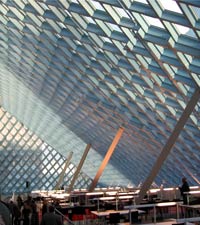
Image 4: Green Buildings in the US: Seattle Central Library. “Our computer modeling resulted in overall energy savings of 33%” Photo and caption courtesy of http://www.arup.com/americas/project.cfm?pageid=241
Green built projects offer inherent benefits to employees, which ultimately benefits the employer as well, who reaps greater economic return from implementing green building practices. The improved work environment that green built projects offer—like better indoor air quality, higher levels of daylight, and improved outdoor views—can result in faster and easier employee recruiting. Additionally, a more pleasant and comfortable work environment reduces employee turnover, which then in turn reduces recruitment and training costs.
Green building also offers the social benefit of supporting sustainable economies. Green built projects can often increase opportunities for local production and manufacture of green building supplies and techniques. For example, a green built project could use local companies that specialize in weatherizing homes or installing solar equipment. [18] This could potentially save transportation costs, and it also stimulates the local economy, keeping money within a local community.
Green built projects can result in a variety of increased marketing capabilities. The most basic of which is a positive public image, due to being socially and environmentally responsible. Green built projects, whether commercial or residential, often lease and sell faster than their traditional counterparts, and frequently at a higher price. This often results in these projects being self-advertising, saving money and gaining free publicity at the same time.
In a competitive environment for sales and leasing, the ability to differentiate a project from everything else out there can have real benefits in terms of attracting and keeping tenants. For example, green built projects have a lower risk for mold and moisture problems, which can in turn result in lower insurance costs. Also, due in part to resource-efficiency, green built projects have reduced operating costs, which consequently increase the property value. [19] Tenants can also be enticed to green built projects due to the potential for increased retail sales. Studies have shown significant levels of increased sales due to the practice of daylighting. Additionally, green projects can appeal to tenants due to a reduced liability risk. As lawsuits over issues like sick-building syndrome and mold become increasing more common, buildings that reduce the risk of these problems will become increasingly in demand. [20]
Additional
Sources:
Greener Building. Accessed on 15 Nov 2005. www.greenerbuilding.com
Rocky Mountain Institute. Accessed on 15 Nov 2005. www.rmi.org
U.S. Environmental Protection Agency, Accessed on 15 Nov 2005. www.epa.gov
[1] Retzlaff, Rebecca. “Building Green: Onus or Bonus?” Zoning Practice, Issue Number 4, Practice Sustainability. American Planning Association, April 2005
[2] Governer’s Green Government Council. “Building Green in Pennsylvania, What is a Green Building? Fundamental Principles of Green Building and Sustainable Site Design.” Pennsylvania’s Governer’s Green Government Council, 2005. Accessed 15 Nov 2005. www.gggc.state.pa.us/gggc/lib/gggc/documents/whatis041202.pdf
[3] Ibid.
[4] Ibid.
[5] Wilson, Alex. “Making the Case for Green Building.” Environmental Building News, Volume 14, Number 4, April 2005. Accessed on 15 Nov 2005. http://www.buildinggreen.com/auth/article.cfm?fileName=140401a.xml
[6] Ibid.
[7] Ibid.
[8] Fisk, William J. “Health and Productivity Gains From Better Indoor Environments and Their Relationship with Building Energy Efficiency.” Annu. Rev. Energy Environ., 25:537-66, 2000. Accessed on 15 Nov 2005. www.usgbc.org
[9] Wilson, Alex. “Making the Case for Green Building.” Environmental Building News, Volume 14, Number 4, April 2005. Accessed on 15 Nov 2005. http://www.buildinggreen.com/auth/article.cfm?fileName=140401a.xml
[10] Ibid.
[11] Ibid.
[12] Dick, Gregory. “Residential Green Building.” California Integrated Waste Management Board, August 24, 2005. Accessed on 15 Nov 2005. www.ciwmb.ca.gov/GreenBuilding/Residential
[13] Dick, Gregory. “Residential Green Building.” California Integrated Waste Management Board, August 24, 2005. Accessed on 15 Nov 2005. www.ciwmb.ca.gov/GreenBuilding/Residential
[14] Wilson, Alex. “Making the Case for Green Building.” Environmental Building News, Volume 14, Number 4, April 2005. Accessed on 15 Nov 2005. http://www.buildinggreen.com/auth/article.cfm?fileName=140401a.xml
[15] Dick, Gregory. “Residential Green Building.” California Integrated Waste Management Board, August 24, 2005. Accessed on 15 Nov 2005. www.ciwmb.ca.gov/GreenBuilding/Residential
[16] Wilson, Alex. “Making the Case for Green Building.” Environmental Building News, Volume 14, Number 4, April 2005. Accessed on 15 Nov 2005. http://www.buildinggreen.com/auth/article.cfm?fileName=140401a.xml
[17] Wilson, Alex. “Making the Case for Green Building.” Environmental Building News, Volume 14, Number 4, April 2005. Accessed on 15 Nov 2005. http://www.buildinggreen.com/auth/article.cfm?fileName=140401a.xml
[18] Ibid.
[19] Ibid.
[20] Ibid.